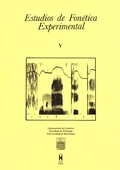Hacia los orígenes de la s aspirada en español
Abstract
This study examines the phonetic principIes which underlie the origin of s-aspiration in Spanish. The change s > h likely derives from inherent limitations in speech perception and parsing in dealing with a potentially ambiguous acoustic signal. It is proposed that aspiration began as coarticulatory forces reduced the auditory distinctiveness of [s] causing listeners to perceive a sound similar to [h].
Many of the robust perceptual cues for [s] are degraded in the original conditions favoring s-aspiration. Furthermore, vowel margins preceding [s] show a breathy voice quality whose auditory properties mimic the effect of postvocalic [h]. It was hypothesized that this murmured vowel offset might be interpreted as intentional aspiration upon removal of the masking [s] noise. Results from perceptual tests support this hypothesis and suggest that this is likely the mechanism which triggered the historical sound change.
Downloads
Published
How to Cite
Issue
Section
License

This work is licensed under a Creative Commons Attribution-NonCommercial-NoDerivatives 4.0 International License.
All articles published online by Estudios de Fonética Experimental are licensed under Creative Commons Attribution-NonCommercial-NoDerivs 4.0 International (CC BY-NC-ND 4.0 DEED), unless otherwise noted. Estudios de Fonética Experimental is an open access journal. Estudios de Fonética Experimental is hosted by RCUB (Revistes Científiques de la Universitat de Barcelona), powered by Open Journal Systems (OJS) software. The copyright is not transferred to the journal: authors hold the copyright and publishing rights without restrictions. The author is free to use and distribute pre and post-prints versions of his/her article. However, preprint versions are regarded as a work-in-progress version used as internal communication with the authors, and we prefer to share postprint versions.




